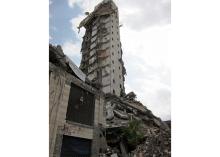In Joshua 5, we come across one of those wonderfully strange biblical stories that shakes our preconceptions and leaves us with more questions than answers.
Israel is encamped at Gilgal, preparing to besiege Jericho at God’s command—so they firmly believe. Suddenly Joshua sees a man whom he does not recognize standing in front of him, sword drawn.
“Whose side are you on?” Joshua asks. A reasonable question in the circumstances.
“Neither,” the man replies. “I have come as commander of God’s armies.”
Wait a second. Isn’t God on Israel’s side? God has delivered them from slavery in Egypt, covenanted with them at Sinai and led them to the Promised Land. If God is not on Israel’s side, who is?
As I write this, modern-day Israel’s armies are besieging and bombing Gaza, preparing to root out the Palestinian terrorist group Hamas. This is a response to Hamas’ horrific rampage of violence, slaughtering and kidnapping Israeli civilians. To this point, over 1,300 Israelis have been killed by Hamas. In response, over 1,500 Palestinians, nearly half of them children, have been killed by Israel.
Here in Canada we as Christians are asked, “Whose side are you on?” A reasonable question in the circumstances. How should we respond?
The way of Jesus helps guide us to an answer. In a world of complex and thorny questions, an increasingly polarized world where we are urged to take sides for and against, Jesus’ way provides the nuance we need and the moral clarity we require.
Jesus, I’m convinced, would give the same answer as the commander of God’s armies gave to Joshua—but still with a strong sense of standing with particular people. For Jesus does take a side. It’s just that the side he takes doesn’t necessarily match up with the binary choices we create.
In the Gospels, we never see Jesus taking the side of a political faction or a nation-state, certainly not one armed and ready for slaughter. Rather, Jesus is consistently on the side of people—real, living, flesh-and-blood people, especially those considered by the world to be “last” or “least” or “lost” (Jesus’ words).
Jesus stands on the side of the broken sinner, ready to repent, and offers forgiveness. Jesus stands on the side of the indebted poor, exploited by wealthy landowners, and offers good news.
Jesus stands on the side of the oppressed, occupied by a foreign power, and offers the earth. Jesus stands on the side of the sick and disabled, physically and financially dependent, and offers healing.
Jesus stands on the side of the widow in her economic distress, the children ignored and powerless, the foreigner in an unfamiliar land, the leper outcast and feared by society, the humble faithful under the thumb of powerful religious leaders, the woman easily divorced by her husband to be left in shame and poverty, the insurgent hanging on a Roman cross, crying out for mercy.
In other words, Jesus consistently stands with the vulnerable-to-harm and the impoverished-in-power, those cast out and pressed down, those too easily and too often crushed and broken.
But for Jesus this does not create categories of people whom he supports (or opposes) as a block, blindly and without question. Again, Jesus stands on the side of real, living, flesh-and-blood people.
While standing with his fellow Jews under Rome’s occupation, he shows grace to a Roman centurion, healing his servant, and calls his compatriots to love their Roman enemies. While standing with the humble faithful under the thumb of some powerful religious leaders, he meets with one of these leaders by night, urging this seeker to be born again to see God’s reign of justice and peace and life.
This is the nuance we need to navigate a complex world. This is the moral clarity we require to enable us to know when, and with whom, and how to take a stand—and with whom to sit and share a meal.
We find Jesus in the “least of these”—the naked, the hungry, the stranger, the imprisoned, Israelis slaughtered by Hamas and Palestinians displaced and occupied and bombed by Israel—and there we stand, with Jesus. We see God’s image in the person right in front of us, regardless of their affiliation or allegiance, and there we sit with them, in grace.
Michael Pahl is executive minister of Mennonite Church Manitoba. He blogs at michaelpahl.com and can be reached at mpahl@mennochurch.mb.ca.




Comments
I commend Michael Pahl for urging his readers to "follow the way of Jesus" and to align our efforts with "the commander of the army of the Lord" (Joshua 5:14), and, to seek and work for peace.
Interestingly, some Bible commentators believe this to be a pre-incarnate appearance of the second person of the Trinity — Jesus. But what I struggle with and lament is when we read in Joshua 6:2 that "... I [the Lord] have delivered Jericho into your hands." What follows is the scene of the Israelites surrounding the walled city and the eventual horrific slaughter of men, women, children and livestock.
These thoughts bubble to the surface after reading Pahl's article and in light of the slaughter of the innocents in Israel and the Palestinian region of Gaza. To justify the slaughter of thousands of precious souls "in the name of the Lord"; is it a true holy war? For Joshua to claim, "... the Lord has given you the city!" (Joshua 6:16) leaves me asking is this the way of Jesus?
Within Christianity, Judaism and Islam, the centuries are blood-stained with "holy wars." God forbid that I would claim that "the Lord has led me into battle." Indeed, Lord have mercy.
Paul Adams, St. Catharines United Mennonite Church (St. Catharines, Ontario)
Add new comment
Canadian Mennonite invites comments and encourages constructive discussion about our content. Actual full names (first and last) are required. Comments are moderated and may be edited. They will not appear online until approved and will be posted during business hours. Some comments may be reproduced in print.